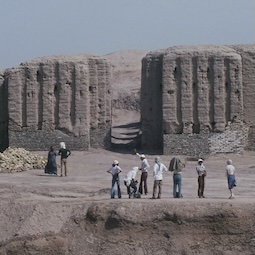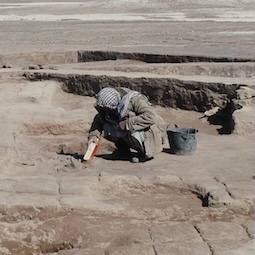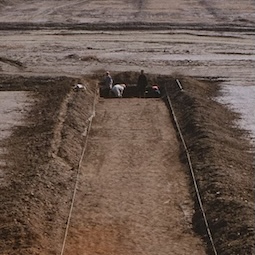Kokushikan University Archaeological Missions, 1988-2001
Although tourists continued to visit both Uhaimir and Ingharra in the decades after the OFME ended in 1933, archaeological work at Kish did not resume for many years. Between November 1966 and March 1967, McGuire Gibson of the University of Chicago's Oriental Institute and Mr Ghanim Wahida of SBAH undertook a systematic topographical survey of Kish and the surrounding area (Gibson 1972). In 1980–81, Iraqi archaeologists from the State Board of Antiquities and Heritage worked at Tell Ingharra, strengthening the foundations of the temple of Ishtar by placing new mud-bricks below the historical floor level (Figure 1). These are the bricks we can still see today. Then, in 1988, the site of Kish was excavated once again, this time by a team of archaeologists from Japan: the Kokushikan University Archaeological Expedition (KUAE).
The KUAE officially commenced work at Tell Ingharra on 16 November 1988 (Figure 2). The mission was led by research director Hideo Fujii, field director Ken Matsumoto, with five researchers including Ogushi Kazumi, plus Ali Hussain Al-Taie and Mumammad Mahmoud Al-Zahwi from SBAH (Matsumoto 1991: 261). The aim of the expedition was to explore the Early Dynastic levels (2900-2334 BCE) of the site, to understand who lived at Tell Ingharra, ancient Hursagkalama, in the third millennium BCE. The team chose to excavate south of the Neo-Babylonian temple of Ishtar, close to "Palace A", which had been discovered by Ernest Mackay in 1924-1925, on Mound A. At barely 10 cm below the surface, the KUAE soon discovered a burial ground, and investigated 17 graves. Many could not be dated, but in some graves, they found personal items next to the skeletons, such as bowls, cylinder seals, and necklaces, bracelets, and rings. Based on this data and on the type of burial, the team estimated that several graves were from the NeoBabylonian or Achaemenid Persian periods, others from the Parthian or Sassanian periods (Matsumoto 1991: 264-276; 284-297).
After this discovery, the KUAE enlarged their excavation area, digging deeper to look for the remains of buildings. Again, close to the surface, about 30cm below ground, the team discovered walls made of sun-dried bricks, going as far as the foot of the hill. These walls delimited small rooms, including one with its doorsocket still close by (Matsumoto 1991: 276-284; 280). This first mission ended on 17 February 1989, with plans to return the following year. But when the Gulf War erupted in August 1990, all plans to return were paused.
Ten years passed before the KUAE was able to return to Tell Ingharra. This second mission ran for three weeks from 9 November 2000 under the direction of Ken Matsumoto, with Hiromichi Oguchi as site supervisor, aided by Iraqi archaeologists Mr Ata Kadim and Mr Mohamad Abdel Rahman from SBAH (Matsumoto & Oguchi 2002: 1). Instead of resuming work where they had last excavated, the team headed north, to the area named Mound P, close to the so-called plano-convex building (PCB) which Mackay had discovered in 1923-1924. They wanted to test Moorey's conclusion that there was probably a major area of urban settlement at area P from the Early Dynastic period onward (Moorey 1978: 42).
The team soon saw walls outlined under the wet soil, across the the extensive flat area east of mound P, thanks to the autumn rain. These walls were so close to the surface that they were easily uncovered by scraping the topsoil to a depth of only 20 to 30 cm. Red coloration suggested they had been burnt in antiquity (Matsumoto & Oguchi 2002: 3-4).
The KUAE returned on 8 September 2001 for their third mission (Figure 3). As before, the team was directed by Ken Matsumoto, with Hiromichi Oguchi as site supervisor, this time assisted by Iraqi archaeologists Salih Youssef and Jewad Muhamad from SBAH. The plan was to continue exploring area P where the team believed houses from the Early Dynastic period would be found (Matsumoto & Oguchi 2002: 1-4). However, work abruptly stopped a week later, after the terrorist attack of 11 September 2001 struck the USA and led to worldwide repercussions. Although the KUAE has not yet resumed their exploration of Tell Ingharra or Area P, the team still hopes to return to Kish one day.
30 Jun 2025
Nadia Aït Saïd-Ghanem
Nadia Aït Saïd-Ghanem, 'Kokushikan University Archaeological Missions, 1988-2001', The Forgotten City of Kish • مدينة كيش المنسية, The Kish Project, 2025 [http://oracc.org/ModernhistoryofKish/KokushikanUniversity1988-2001/]


